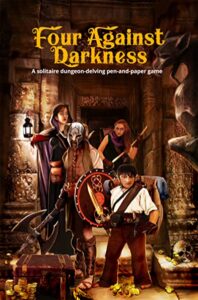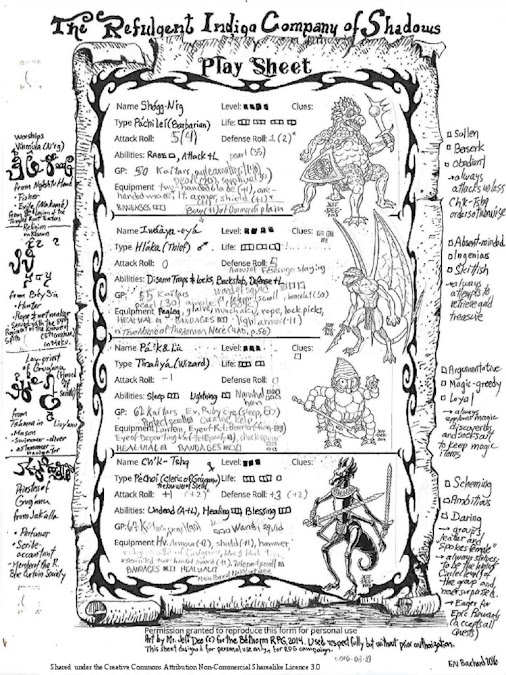I have always been a fan of tabletop RPGs, but as I got older and my friends became busier with their lives, it became harder to schedule regular game nights. That’s when I discovered solo RPGs, and one game that quickly became a favorite of mine is Four Against Darkness.
The rules are simple, but they offer enough depth and variety to keep the game interesting and challenging. Characters are chosen for their class which has pre-generated traits and equipment. It is up to your imagination to supply their names and personalities.
As you move through the dungeon, you roll dice to figure out what you encounter. The game master (i.e., you) then consults tables in the rulebook to decide the details of the encounter. These tables cover everything from traps and puzzles to monsters and treasure.
One of my favorite encounters happened during a playthrough with a dwarf and an elf. The dwarf, Grimngar, was a gruff, no-nonsense fighter who had a deep mistrust of magic. The elf, Nimue, was a delicate spellcaster who was fascinated by the mysteries of the universe.
As they explored the dungeon, they came across a room that was filled with strange runes etched into the floor. Nimue recognized them as symbols of great power at once and began to study them intently. Grimngar, on the other hand, was convinced that they were a trap and warned Nimue to stay back.
But Nimue was too curious to heed Grimngar’s warning. She stepped forward and traced the runes with her finger, murmuring a quiet incantation under her breath.
Suddenly, the room began to shake and the runes on the floor began to glow with an otherworldly light. Grimngar drew his sword and prepared for battle, but Nimue was lost in concentration, her eyes fixed on the swirling energy in the center of the room.
The energy coalesced into a shimmering portal, and out stepped a towering figure clad in black armor. It was a powerful demon, summoned by Nimue’s spell.
Grimngar charged forward, his sword raised high, but the demon easily parried his blows and sent him flying across the room. Nimue, finally snapping out of her trance, realized the gravity of her mistake and began to frantically search for a way to banish the demon back to its own realm.
It was a tense and harrowing encounter, and I’m ashamed to say that Grimngar didn’t make it out alive. But it was a reminder that Four Against Darkness is a game that can be unforgiving and brutal. One wrong move can mean the difference between victory and defeat.
But it’s also a game that rewards careful planning and strategy. The key is to know when to press forward and when to retreat, when to fight and when to run. It’s a delicate balance, and one that can be difficult to master.

Game Mechanics
Four Against Darkness is a solo role-playing game that has gained quite a following over the years. Developed by Italian game designer Andrea Sfiligoi and published by Ganesha Games, it has become a staple of the solo gaming community.
The game is set in a dark and mysterious dungeon, filled with all sorts of creatures and traps that are just waiting to catch the player off guard. The objective is to navigate through the dungeon and find the ultimate treasure, all while avoiding certain death.
It is meant for a party of four characters between levels 1-4. Each character is controlled by a single player: you. There is also a supplement Four Against the Abyss, which extends your characters’ adventures to levels 5-9.
Although the game can be bought print-on-demand from some places such as Amazon, its roots are firmly planted in the world of print-and-play tabletop gaming with a dash of spice from the world of gamebooks.
As with most RPGs, the first step in playing the game is to create a party of adventurers. The player can choose from a variety of classes such as warrior, rogue, wizard, cleric, barbarian, elf, dwarf or halfling. Each class has its own strengths and weaknesses, and the player must carefully select which characters to include in their party.
Once the party is assembled, the player can start exploring the dungeon. The dungeon is made up of a series of rooms, and each room has its own set of challenges. The player must use their wits and their characters’ abilities to overcome these challenges and progress through the dungeon.
One of the unique aspects of Four Against Darkness is the way the game is played. As a solo RPG, instead of using a game master or dungeon master to guide the players, the game uses a set of rules and tables to generate the dungeon and the encounters. This means that the player is playing against the game itself, and every decision they make has a direct impact on the outcome.
Combat
One of the things that sets Four Against Darkness apart from other RPGs is the way it handles combat. The rules are straightforward and easy to follow, but complex enough to keep things interesting.
When you attack a monster, you roll a d6 and add various modifiers from the character’s class and equipment. If the result is equal to the monster’s level, you hit and do damage. If the result is one more than the monster’s level (or higher), you also avoid any damage to your character.
This system keeps combat fast and fluid, but also gives some satisfying complexity for the inner grognard in us all.
Exploration
Another unique aspect of Four Against Darkness is the way it handles exploration. As you move through the dungeon, you roll dice to determine what you encounter. This can include traps, puzzles, monsters, treasure, and more.
The encounters are determined by consulting tables in the rulebook, which supply a wide variety of options. For example, when rolling for a trap, you might end up with a pit trap, a poison dart trap, or a collapsing ceiling. When rolling for treasure, you might find gold, gems, magical items, or even cursed items that bring trouble down the line.
This randomization adds an element of unpredictability to the game, making each play-through unique and challenging. It also encourages creative problem-solving, as you must think on your feet to overcome the various obstacles and challenges that come your way.
Overall, Four Against Darkness is a game that rewards careful planning and strategic thinking. It’s not a game that you can win by charging in blindly and swinging your sword, but rather one that requires patience, cunning, and a bit of luck.
That being said, the game is not without its frustrations. There will be times when you roll poorly and your characters suffer needless deaths, or when you encounter a particularly difficult challenge that seems impossible to overcome.
But these moments of failure are part of what makes the game so rewarding. When you finally do succeed after a long and difficult struggle, it feels all the more satisfying because of the obstacles you had to overcome.

Mapping
One of the key elements of Four Against Darkness is the mapping system. As you explore the dungeon, you must keep track of where you’ve been and where you’re going on a piece of graph paper.
Each room in the dungeon is represented by a square on the map, with doors leading to other rooms and corridors. It’s important to note the location of any traps, monsters, or treasure you encounter, as well as any secret passages or hidden doors that you discover.
This mapping system adds an element of realism to the game, as you must rely on your memory and your notes to navigate the dungeon. It also adds an element of danger, as you can easily get lost or backtrack accidentally if you’re not paying attention.
One of the keys to successful mapping is to keep your notes organized and clear. Use different symbols or colors to denote distinct types of encounters, and make sure to label each room and corridor clearly. You can also use shorthand or abbreviations to save time and space on your map. Better yet, use specialized cards and game aids made to enhance the game.
Overall, the mapping system in Four Against Darkness adds an immersive and challenging element to the game. It requires you to stay focused and attentive, and it rewards careful planning and note-taking. By following these tips and keeping your map clear and organized, you’ll be well on your way to success in the dungeon.
Game Play
One of the biggest challenges in Four Against Darkness is keeping your characters alive. It’s easy to get attached to your characters and their unique personalities, so it’s important to take steps to keep them safe and avoid unnecessary deaths.
One of the best ways to keep your characters alive is to min-max their stats and skills. This means focusing on their strengths and abilities, and making sure they are equipped with the right gear for their particular play style.
For example, if you have a character with high strength and low dexterity, it’s probably not a promising idea to have them using a ranged weapon like a bow. Instead, focus on giving them a melee weapon like a sword or axe, and focus on building their strength and hit points to make them a formidable tank.
Similarly, if you have a character with high intelligence and low strength, consider giving them a support role like a healer or spellcaster. This will allow them to contribute to the party without putting themselves in too much danger.
In terms of character creation, there are a few things to keep in mind if you want to min-max your characters. First, focus on the stats and skills that are most important for your play style. If you’re going for a tank build, focus on strength and hit points. If you’re going for a ranged build, focus on dexterity and ranged weapons.
Second, consider giving each character a unique role within the party. This will help you to specialize and make the most of each character’s strengths. For example, you might have one character who is focused on combat, another who is focused on healing, and a third who is focused on exploration and trap-disarming.
Finally, don’t be afraid to experiment with unconventional character builds and play styles. The beauty of Four Against Darkness is that it’s a flexible and adaptable game, and there are many ways to approach it. So be creative, have fun, and don’t take it too seriously!
It’s also important to be prepared for emergencies. Always carry healing potions and antidotes, and make sure your party has a variety of weapons and equipment to handle diverse types of challenges. Don’t be afraid to retreat from a difficult encounter if you’re not well-equipped or well-prepared.
In addition to these tips, it’s important to remember that luck plays a significant role in Four Against Darkness. Sometimes, no matter how well-prepared you are, things just don’t go your way. When this happens, don’t get discouraged. Use it as an opportunity to learn from your mistakes and come back stronger in the next playthrough.